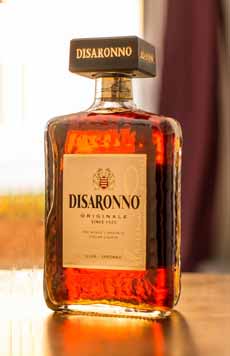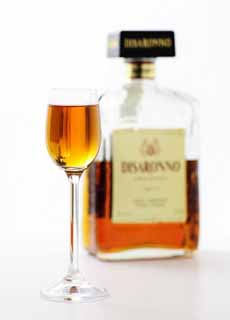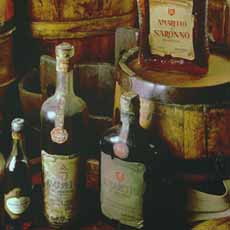FOOD 101: The History Of Amaretto Liqueur
 [1] Disaronno, the original amaretto liqueur brand (photos #1, #3 and #4 © ILLVA).
[4] Bottles of Disaronno from 1900. |
April 19th is National Amaretto Day. Earlier today, we developed a list of almost 40 ways to use amaretto.
You may find it hard to believe that one of the top liqueurs in the world (see the list below) was not imported into the U.S. until the 1960s. The almond-flavored cordial quickly became a hit in the U.S., in cocktails and food preparation. By the 1980s, it was second in sales only to Kahlùa. (Today, the top liqueurs are Baileys Irish Cream and Malibu Caribbean Rum.) (What’s the difference between a cordial, a liqueur and an eau de vie? Here’s the answer. In Italian, amaro means bitter. Amaretto means a little bitter. Why is this sweet, almond liqueur called bitter? Surprisingly, no almonds are used to make most brands of amaretto. Rather, the marzipan-like flavor is achieved through apricot kernel oil, burnt sugar and a variety of spices. Various commercial brands—but not the top two which “own” the market—are made from a base of apricot pits or peach pits (the source of the oil), almonds, or a combination. Most likely, when it was first made, amaretto wasn’t as sweet as it is today. Older recipes use the bitter almond (mandorla amara) local to Saronno, Italy, which give the liqueur its name. In Italy, almonds are grown in two basic varieties, sweet and bitter (mandorla). Before the names DiSaronno or Lazzaroni ever appeared on a bottle, the amaretto legend was born. In the Renaissance and earlier, many families would distill their own liqueurs and digestifs. According to their history, here’s the scoop: In 1525, the artist Bernardino Luini, a former pupil of Leonardo da Vinci, was commissioned by the Basilica of Santa Maria delle Grazie in the city of Saronno, in northern Italy near the Swiss border, in the region of Lombardy. He painted a fresco of the the Adoration of the Magi (photo #5) in the sanctuary, which included the Madonna of the Miracles (photo #6). The fresco can still be seen today). As the model for the Madonna, Luini hired a young widow, an innkeeper. As a gift, she gave him a flask full of an amber liqueur she made by steeping apricot kernels in brandy. Her name is lost to history, but her likeness and her amaretto recipe live on. Perhaps she was a member of the Reina family; for somehow, in 1600, Giovanni Reina (who had worked for the Lazzaroni amaretto cookie business) discovered the innkeeper’s old recipe. He made the liqueur, and the “secret” recipe passed from one generation to the next. 20th Century Amaretto Di Saronno At the beginning of the 20th century, Domenico Reina decided to open a store in Saronno to sell food items, including the family liqueur, which he sold as Amaretto di Saronno Originale (Original Amaretto from Saronno, photo #4). The store was called Domenico Reina Coloniali (Domenico Reina’s Grocery—photo #3). By 1940, liqueur production had grown into a large artisanal business. In 1947 was incorporated as ILLVA SARONNO. ILLVA is an acronym for Industria, Lombarda, Liquori, Vini & Affini (Industry, Lombarda, Spirits, Wines & Allied Products). The product was called Amaretto di Saronno (Amaretto from Saronno), before returning to the latter part of the original name, Disaronno Originale, in 2001. It is still produced in Saronno, and sold worldwide (source). It should be noted that Paolo Lazzaroni & Figli S.p.A., makers of Amaretti di Saronno cookies, claims that the Lazzaroni family created amaretto, in 1851. |
|
|
That may be so, but their recipes are quite different. Disaronno’s is made from apricot kernel oil with “absolute alcohol, burnt sugar, and the pure essence of seventeen selected herbs and fruits” (i.e., no almonds or other nuts). Lazzaroni’s amaretto contains their Amaretti di Saronno almond cookies, infused in alcohol (source). |
||
|
CORDIAL, LIQUEUR, EAU DE VIE: THE DIFFERENCE Most people—including American producers and importers—use these terms interchangeably. But there are differences: |
 [6] Adoration Of The Magi by Bernardo Luini.
|
|
|
EAU DE VIE, “WATER OF LIFE” Centuries ago, eau de vie was a term used to describe all distilled spirits. It’s original use was medicinal, which is why it was called water of life. The distillation of alcohol may have taken place as early as 200 C.E., possibly by alchemists trying to make gold (alembic still history). The Gaelic uisce beatha, pronounced ISH-ka BYA-ha, too, means “water of life.” The pronunciation evolved into the more familiar term, whiskey. How about an apéritif (French) or an aperitivo (Italian)? These don’t refer to the contents of a drink; but rather, to the timing. They are a range of alcoholic beverages that are drunk to stimulate the appetite. Traditional choices for an apéritif are champagne; gin; anise-flavored liqueurs (arak, pastis, raki and others); dry white wine (a light style); sherry (amontillado, fino or dry sherry; and vermouth (a fortified white wine). At the opposite end, a digestif is an after-dinner drink to help with digestion. These include amaros, fortified wines, brandies and herbal liqueurs. According to The Spirit Business, the top-selling liqueur brands in the world are: 1. Baileys Irish Cream (whiskey flavored) *The African fruit from which this is made has been described as tasting like chocolate-covered strawberries. It is a favorite of elephants.
|
||






